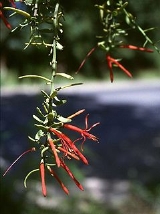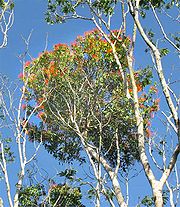
Loranthaceae
Encyclopedia

Family (biology)
In biological classification, family is* a taxonomic rank. Other well-known ranks are life, domain, kingdom, phylum, class, order, genus, and species, with family fitting between order and genus. As for the other well-known ranks, there is the option of an immediately lower rank, indicated by the...
of flowering plant
Flowering plant
The flowering plants , also known as Angiospermae or Magnoliophyta, are the most diverse group of land plants. Angiosperms are seed-producing plants like the gymnosperms and can be distinguished from the gymnosperms by a series of synapomorphies...
s, which has been universally recognized by taxonomists. It consists of about 75 genera
Genus
In biology, a genus is a low-level taxonomic rank used in the biological classification of living and fossil organisms, which is an example of definition by genus and differentia...
and 1,000 species
Species
In biology, a species is one of the basic units of biological classification and a taxonomic rank. A species is often defined as a group of organisms capable of interbreeding and producing fertile offspring. While in many cases this definition is adequate, more precise or differing measures are...
of woody plant
Woody plant
A woody plant is a plant that uses wood as its structural tissue. These are typically perennial plants whose stems and larger roots are reinforced with wood produced adjacent to the vascular tissues. The main stem, larger branches, and roots of these plants are usually covered by a layer of...
s, many of them hemi-parasites
Parasitic plant
A parasitic plant is one that derives some or all of its sustenance from another plant. About 4,100 species in approximately 19 families of flowering plants are known. Parasitic plants have a modified root, the haustorium, that penetrates the host plant and connects to the xylem, phloem, or...
, all of them except three having the mistletoe
Mistletoe
Mistletoe is the common name for obligate hemi-parasitic plants in several families in the order Santalales. The plants in question grow attached to and within the branches of a tree or shrub.-Mistletoe in the genus Viscum:...
habit. The three terrestrial species are Nuytsia floribunda - the Western Australian Christmas tree, Atkinsonia ligustrina - a rare shrub of the Blue Mountains of Australia, and the Central to South American species of Gaiadendron punctatum.
Originally Loranthaceae contained all mistletoe species, but the typical Christmas mistletoes of Europe and North America (the genera Viscum
Viscum
Viscum is a genus of about 70-100 species of mistletoes, native to temperate and tropical regions of Europe, Africa, Asia and Australasia. Traditionally, the genus has been placed in its own family Viscaceae, but recent genetic research by the Angiosperm Phylogeny Group shows this family to be...
and Phoradendron
Phoradendron
Phoradendron is a genus of mistletoes, native to warm temperate and tropical regions of the Americas. Traditionally, the genus has been placed in the family Viscaceae, but recent genetic research acknowledged by the Angiosperm Phylogeny Group shows this family to be correctly placed within a larger...
) belong to the family Santalaceae
Santalaceae
Santalaceae is a widely distributed family of flowering plants which, like other members of Santalales, are partially parasitic on other plants...
; previously these two genera and their closest relatives were in a separate family, Viscaceae
Viscaceae
Viscaceae is a family of flowering plants. In past decades, several systems of plant taxonomy recognized this family, notably the 1981 Cronquist system...
, which has been merged into Santalaceae.
The APG II system
APG II system
The APG II system of plant classification is the second, now obsolete, version of a modern, mostly molecular-based, system of plant taxonomy that was published in April 2003 by the Angiosperm Phylogeny Group. It was a revision of the first APG system, published in 1998, and was superseded in 2009...
(2003; unchanged from the APG system
APG system
The APG system of plant classification is the first, now obsolete, version of a modern, mostly molecular-based, system of plant taxonomy that was published in 1998 by the Angiosperm Phylogeny Group. It was superseded in 2003 by a revision, the APG II system, and then in 2009 by a further...
of 1998) assigns the family to the order Santalales
Santalales
Santalales is an order of flowering plants with a cosmopolitan distribution, but heavily concentrated in tropical and subtropical regions.Most have seeds without a testa, which is unusual for flowering plants...
in the clade core eudicots.
Genera
|
Helixanthera Helixanthera is moderately sized genus of showy mistletoe with about 35 species from tropical Africa, southern Asia and Malesia. The genus was described already 1790 by the Portugues botanist Loureiro in his Flora Cochinchinensis. A new species, Helixanthera schizocalyx, was described as late as... Trithecanthera Trithecanthera is a genus of showy mistletoes in the family Loranthaceae. It contains approximately 5 species in the Malesian region of South East Asia. The genus includes the species described within the genus Kingella as Kingella scortechinii.... Loranthus Loranthus is a genus of mostly parasitic plants that grow on the branches of woody trees. It belongs to the family Loranthaceae, the showy mistletoe family... |
Lysiana Lysiana is a genus of parasitic shrubs, endemic to Australia.Species include:*Lysiana casuarinae Tiegh. *Lysiana exocarpi Tiegh. *Lysiana filifolia Barlow *Lysiana linearifolia Tiegh.... Peraxilla Peraxilla is genus of two showy mistletoe species from New Zealand. It contains the two species Peraxilla colensoi and Peraxilla tetrapetala.... |
Psittacanthus Psittacanthus is a plant genus in the family Loranthaceae.Species include:* Psittacanthus barlowii* Psittacanthus cupulifer* Psittacanthus flavo-viridis Eichler* Psittacanthus pluricotyledonarius Rizzini... Socratina Socratina is genus of two showy mistletoe species in Madagascar. The genus was described by the Belgian botanist Simone Balle in Flora de Madagascar, 1964, and it contains the two species Socratina bemarivensis and Socratina kerauderiana.... Struthanthus Struthanthus is a genus of plant in family Loranthaceae. It contains the following species :* Struthanthus lojae, Kujit... Tapinanthus Tapinanthus is a genus of plant in family Loranthaceae. It contains, among others, the following species:* Tapinanthus letouzeyi, R.M. Polhill & D. Wiens* Tapinanthus preussii, Tiegh.* Tapinanthus globifer... Tristerix Tristerix is a genus of mistletoe in the family Loranthaceae, native to the Andes from Colombia to Chile. They are a woody perennial usually occurring as an aerial parasite, often pollinated by hummingbirds... Trithecanthera Trithecanthera is a genus of showy mistletoes in the family Loranthaceae. It contains approximately 5 species in the Malesian region of South East Asia. The genus includes the species described within the genus Kingella as Kingella scortechinii.... |

